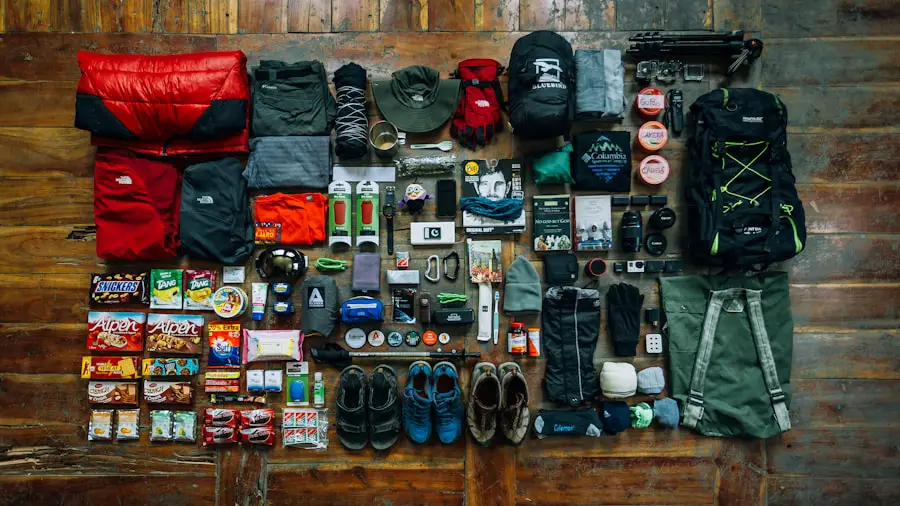Hiking is a popular outdoor activity that involves walking in natural environments, often on trails or paths. It can range from leisurely strolls in local parks to challenging treks in rugged wilderness areas. The appeal of hiking lies in its ability to connect individuals with nature, offering both physical exercise and mental rejuvenation.
As a form of recreation, hiking can be enjoyed solo or in groups, making it a versatile activity suitable for people of all ages and fitness levels. The simplicity of hiking is one of its greatest attractions; all one needs is a pair of sturdy shoes and a sense of adventure. The origins of hiking can be traced back to ancient times when people traversed landscapes for survival, exploration, and trade.
Today, it has evolved into a popular pastime that promotes physical health and well-being. Hiking not only provides cardiovascular benefits but also enhances mental clarity and emotional stability. The rhythmic movement of walking, combined with the sights and sounds of nature, can lead to a meditative state, reducing stress and anxiety.
Understanding the basics of hiking involves recognizing its benefits, knowing the different types of trails available, and appreciating the natural world that surrounds us.
Key Takeaways
- Hiking is a form of outdoor activity that involves walking in natural environments such as mountains, forests, and trails.
- Essential gear for hiking includes proper footwear, clothing, backpack, navigation tools, first aid kit, and water and food supplies.
- Beginners should choose well-marked and well-maintained trails with moderate difficulty to start their hiking journey.
- Safety tips for hiking include informing someone about your hiking plans, staying hydrated, being aware of wildlife, and being prepared for changing weather conditions.
- Hikers should follow proper etiquette such as staying on designated trails, minimizing noise, and packing out all trash, as well as leave no trace principles to minimize their impact on the environment.
Essential Gear and Equipment for Hiking
When preparing for a hike, having the right gear is crucial for both safety and comfort. The foundation of any hiking outfit begins with appropriate footwear. Hiking boots or shoes should provide adequate support, traction, and protection for the feet.
A well-fitted pair can prevent blisters and injuries on uneven terrain. Additionally, moisture-wicking socks are essential to keep feet dry and comfortable throughout the hike. Beyond footwear, clothing should be chosen based on the weather conditions and the intensity of the hike.
Layering is key; breathable base layers, insulating mid-layers, and waterproof outer layers can help regulate body temperature and protect against the elements. In addition to clothing, several essential items should be included in a hiker’s pack. A reliable backpack is necessary to carry water, snacks, and other supplies.
Hydration systems or water bottles are vital to prevent dehydration, especially on longer hikes. Snacks high in energy, such as trail mix or energy bars, can provide necessary fuel during the trek. Navigation tools like maps, compasses, or GPS devices are also important for staying on course.
First aid kits should not be overlooked; they can address minor injuries or ailments that may arise during the hike. Finally, a multi-tool or knife can be invaluable for various tasks, from food preparation to emergency situations.
Choosing the Right Trail for Beginners

Selecting an appropriate trail is essential for novice hikers to ensure a positive experience. Beginners should look for trails that are well-marked and maintained, with clear signage indicating difficulty levels. Easy trails typically feature gentle inclines and well-defined paths, making them accessible for those who may not have extensive hiking experience.
Local parks or nature reserves often have beginner-friendly trails that allow newcomers to acclimate to hiking without overwhelming them. Researching trail conditions before heading out is also important. Websites and apps dedicated to hiking often provide user reviews and updates on trail status, which can help beginners avoid unexpected challenges such as closures or difficult weather conditions.
Additionally, considering the length of the trail is crucial; shorter hikes allow beginners to build confidence without overexerting themselves. As they gain experience and endurance, they can gradually progress to more challenging trails that offer greater rewards in terms of scenery and adventure.
Safety Tips and Precautions for Hiking
| Safety Tips and Precautions for Hiking |
|---|
| 1. Plan your route and inform someone of your plans |
| 2. Check the weather forecast before heading out |
| 3. Wear appropriate clothing and footwear |
| 4. Carry enough water and stay hydrated |
| 5. Pack essential items such as a map, compass, first aid kit, and flashlight |
| 6. Stay on marked trails and follow trail signs |
| 7. Be aware of wildlife and respect their habitat |
| 8. Take regular breaks and pace yourself |
| 9. Be mindful of your surroundings and watch for hazards |
| 10. Leave no trace – pack out all trash and waste |
Safety should always be a top priority when hiking, regardless of experience level. One of the most important precautions is to inform someone about your hiking plans before setting out. This includes sharing your intended route and estimated return time.
In case of an emergency, having someone aware of your whereabouts can be crucial for rescue efforts. Additionally, hikers should always check weather forecasts prior to their trip; sudden changes in weather can pose significant risks, especially in mountainous areas where conditions can shift rapidly. Another key safety measure is to stay on marked trails.
Venturing off established paths can lead to getting lost or encountering hazardous terrain. It’s also wise to hike with a buddy whenever possible; having a companion not only enhances safety but also makes the experience more enjoyable. Carrying a fully charged mobile phone can provide an additional layer of security, allowing hikers to call for help if needed.
However, it’s important to remember that cell service may be limited in remote areas, so relying solely on technology is not advisable.
Proper Hiking Etiquette and Leave No Trace Principles
Hiking etiquette plays a significant role in ensuring that everyone enjoys their outdoor experience while preserving nature for future generations. One fundamental principle is yielding the right of way; hikers traveling uphill generally have the right of way over those descending. This courtesy helps maintain a smooth flow on trails and minimizes disruptions.
Additionally, when encountering other hikers or groups, it’s polite to greet them with a friendly nod or hello, fostering a sense of community among outdoor enthusiasts. The Leave No Trace principles are essential guidelines that promote responsible outdoor ethics. These principles encourage hikers to minimize their impact on the environment by staying on designated trails, packing out all trash, and respecting wildlife by observing from a distance rather than approaching or feeding animals.
Campfires should only be built in designated areas when permitted, as they can cause lasting damage to ecosystems if not managed properly. By adhering to these principles, hikers contribute to the preservation of natural spaces for others to enjoy while maintaining the integrity of the environment.
Building Physical Endurance and Strength for Hiking

Preparing physically for hiking is crucial for enhancing performance and enjoyment on the trail. Building endurance involves gradually increasing cardiovascular fitness through activities such as walking, running, cycling, or swimming. Incorporating interval training—alternating between high-intensity bursts and lower-intensity recovery periods—can significantly improve stamina over time.
Additionally, engaging in strength training exercises focusing on core stability and leg strength will help hikers navigate uneven terrain more effectively. Incorporating specific exercises into a regular fitness routine can also prepare individuals for the demands of hiking. Squats and lunges strengthen leg muscles while improving balance and stability.
Core exercises like planks enhance overall body strength, which is essential for maintaining proper posture during long hikes. Flexibility training through yoga or stretching routines can prevent injuries by promoting muscle elasticity and joint mobility. By committing to a well-rounded fitness regimen that includes cardiovascular conditioning, strength training, and flexibility work, aspiring hikers can build the physical foundation necessary for tackling various trails.
Exploring Different Types of Hiking Terrain
Hiking offers an array of terrains that cater to diverse preferences and skill levels. Each type presents unique challenges and rewards that can enhance the overall experience. For instance, forested trails often provide shaded paths lined with trees that create a serene atmosphere while offering protection from direct sunlight.
These trails may feature gentle slopes and soft ground cover, making them ideal for beginners or those seeking a leisurely outing. In contrast, mountainous terrain presents more demanding challenges with steep ascents and rocky paths that require greater physical exertion and technical skills. Hikers on these trails are rewarded with breathtaking vistas at higher elevations but must be prepared for changing weather conditions and potential altitude sickness.
Desert hikes offer another distinct experience; they often feature vast open spaces with unique flora and fauna adapted to arid conditions. Hikers must be mindful of hydration in these environments due to high temperatures and limited shade.
Joining Hiking Groups and Communities for Support and Guidance
For those new to hiking or looking to expand their experiences, joining hiking groups or communities can provide invaluable support and guidance. Many local outdoor organizations offer group hikes led by experienced leaders who can share knowledge about trail navigation, safety practices, and environmental stewardship. These groups often cater to various skill levels, allowing beginners to learn from seasoned hikers while building confidence in their abilities.
Online platforms and social media have also made it easier than ever to connect with fellow hiking enthusiasts. Websites dedicated to outdoor activities often feature forums where individuals can share tips, plan group outings, or seek advice on specific trails or gear recommendations. Engaging with these communities fosters camaraderie among hikers while providing opportunities for mentorship and friendship in shared outdoor pursuits.
Whether through local clubs or online networks, finding a supportive community can enhance one’s hiking journey significantly while encouraging exploration of new trails and terrains.
If you are looking to start hiking as a hobby, you may want to check out this article on The Shepherd’s Journey to Bethlehem: A Distance Traveled. This article provides insights into the journey taken by shepherds to Bethlehem and can inspire you to embark on your own hiking adventures. It’s a great way to learn more about the history and culture of a place while enjoying the great outdoors.
FAQs
What is hiking?
Hiking is a recreational activity that involves walking on trails or paths in natural environments such as forests, mountains, and countryside.
Why should I start hiking as a hobby?
Hiking is a great way to stay active, connect with nature, and reduce stress. It also provides opportunities for exploration and adventure.
How do I start hiking as a beginner?
To start hiking as a beginner, it’s important to choose easy and well-marked trails, wear appropriate clothing and footwear, and bring essential supplies such as water, snacks, and a map.
What are some essential items to bring when hiking?
Essential items to bring when hiking include water, snacks, a map, a compass, a first aid kit, sunscreen, insect repellent, and appropriate clothing and footwear.
How can I find hiking trails near me?
You can find hiking trails near you by using websites and apps that provide information on local trails, visiting national or state parks, or joining hiking clubs and groups in your area.
What are some safety tips for hiking?
Some safety tips for hiking include informing someone of your hiking plans, staying on marked trails, being aware of wildlife, checking the weather forecast, and carrying a whistle or signaling device.
How can I improve my hiking skills?
You can improve your hiking skills by gradually increasing the difficulty of the trails you hike, learning navigation and map reading, practicing Leave No Trace principles, and taking hiking and outdoor safety courses.
